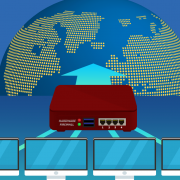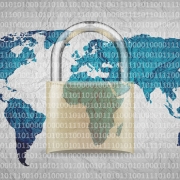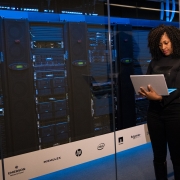Why You Need Both Software and Hardware Firewalls
A firewall sounds like a pretty intense thing – unless you’re an action-movie stuntman. Yet when it comes to internet security, you may not have as much firewall protection as you need.
Many internet security products bundle antivirus and firewall software, and many users think this is enough. But first, let’s be clear about what a software firewall actually does:
- It regulates data through port numbers and applications.
- It allows you to block incoming traffic from certain locations.
- It distinguishes between computer programs allowing data to one program while blocking another.
- It blocks traffic attempting to leave a device to access other devices on your network.
There are drawbacks, though. Software firewalls work only on the computers on which they are installed, and you’ll need to buy multiple licenses to protect several computers.
You also need expertise to administer the firewall to keep up with changing threats. And there are security threats. Bad actors target software firewalls. They’re right there on the computer they seek to exploit.
Beefing Up Your Firewalls
Many businesses also use hardware firewalls to add security. A hardware firewall around your office network acts as a perimeter boundary. The hardware firewall is like the border guard keeping an eye out for dangerous traffic. The firewall inspects incoming internet traffic to protect you from malware and cyberthreats.
IT experts can set up firewalls to pass only safe data. This adds a layer of protection to your network and also secures network-connected devices. Workstations, printers, digital equipment, and telephone systems often don’t have software firewalls.
So, combining firewalls protects both local computers and other devices on your network. The hardware firewall checks traffic coming in from and going out to the internet, whereas the software firewall secures what’s coming into or out of the computer, even from internet sources.
Think about it this way: A cybercriminal is trying to access your systems. They take many approaches, one of which is trying to breach your network perimeter. Another is sending targeted communications to sucker someone into clicking on a virus-laden email. The hardware firewall could stop the perimeter attack, but the software helps stop the malware infection spreading from the user’s computer to others in your office.
Partner with a Firewall Expert
Firewalls can give your business tremendous control over:
- how users connect to the internet;
- what information is retrieved from the internet;
- whether files can leave the company over the network;
- what devices are accessible and from where.
Yet both software and hardware firewalls need the right expertise to install correctly. Firewalls must be regularly monitored and managed, because threats are constantly changing.
Combining firewalls adds protection but only if you configure them to minimize weaknesses. You’ll need someone to identify compatibility issues and avoid blocking legitimate data.
Partner with an IT expert. We know how to work with firewall rules, and understand what they mean and how to react to alerts generated. Have you heard of a breach that compromised Target’s point of sale systems? That fiasco involved ignored firewall alerts! Don’t let it happen to you.
We can help you set up and maintain the firewall protection you need. Contact us today at 888-333-9757! You can also book a discovery call so we can go over your business needs and see which solution is best for you.
Invest Now in Your Top Tech Priorities
The global economy is in a slump. But believe it or not, now could be a good time to invest in technology priorities.
You may already have streamlined processes. You had certain technology tools and systems in place to get things done. It all was working fine. Yet 2020 brought many challenges to the way business functions. The technology you relied on in the past may not be the best answer to your current business needs.
You might have been putting off cloud migration, as most work was onsite, or you resisted remote working out of concern that employee productivity would suffer. Perhaps your business didn’t want to secure a “Bring Your Own Device” workplace.
Now, you need to rethink how your employees report for work. You could be facing any of 2020’s familiar challenges such as:
- a server that could support your teams overburdened by remote workers;
- a reliance on email document exchange causing difficulties with version control and accountability;
- not having enough software licenses to accommodate employees working from home;
- employees lacking the technology to get work done offsite.
Businesses need to act now to address their new technology needs. Keep in mind that many vendors are offering discounted services, plus, you may find it easier to access business loans for tech investments.
Stepping Up Your Tech Game
Some businesses are struggling to keep their doors open. Others are waiting out the current situation to see how things shake out. Then there are those that are rolling the dice and betting on a rebound. Improving the IT environment can be a foundation for future business success.
Plans may have already been in place to invest in a systems or hardware upgrade or migrate to the cloud. Continuing the digital transformation journey, when everyone is adapting already, could make sense. Reduce negative impacts by making the change while employees are working remotely. Downtime may not be as big of a challenge.
Your business may also invest in data backups and disaster recovery solutions. Didn’t have business continuity plans in place? You’ve likely realized their importance now. These plans prepare your business for data breaches, ransomware attacks, power outages, or natural disasters. Contracting for cloud data backup pays off when you can recover quickly and cut damage done.
Starting a partnership with a managed service provider (MSP) is also helpful. An MSP gets to know your business and its systems and needs. They can help find cost savings and identify opportunities for greater efficiencies. They can also offer expert IT advice, manage and track your data backups and cybersecurity, or take on day-to-day tasks, freeing up your IT team for revenue-generating innovation.
If you’re thinking of making a tech investment, contact us today. We’re available to consult on the best solutions for your business needs.
Our experts can put your plans into practice while you focus on your business recovery. Contact us today at 888-333-9757!
3 Cyberattackers Putting Businesses at Risk
Cyberattacks and data breaches happen worldwide, and no one is immune. Your business needs to protect its networks and systems, and secure sensitive data. But how much do you know about the types of cybercriminal out there. This roundup discusses the biggest threats and what they’re after.
Cybercrime Gangs
Online crime is a lucrative industry. Cybergangs go online to offer “crime as a service.” Their targets vary and can be spread out globally. In 2019, one international crime gang stole $100 million from more than 40,000 victims. Culprits were found in the US, Bulgaria, Germany, Georgia, Moldova, and Ukraine. Victims included small businesses, law firms, international corporations, and nonprofits.
Many of these bad guys may have started out in the digital environment, but well-established street gangs are turning their attention to cybercrime too.
Typically well-funded and organized, cybergangs work long-term to mount large-scale attacks. They target banks, law firms, healthcare networks, and other big businesses.
Still, small businesses can be targeted by cybercrime gangs. You could be the first domino to compromise a larger, more lucrative target in your supply chain.
State-based Actors
One nation pays an individual or group to target another country. On the digital battlefield this could mean:
- tampering with an election;
- infiltrating another country’s banking system;
- compromising critical infrastructure;
- accessing intelligence;
- creating incidents of international significance;
- engaging in propaganda, disinformation campaigns;
- espionage.
Australia recently announced a “sophisticated state-based cyberattack” on political and private-sector organizations.
State actors also used cyber techniques to damage Iran’s nuclear program. They left an infected thumb drive in the parking lot. A well-meaning staffer found the USB and plugged it into the facility computers. The virus caused Iran’s fast-spinning centrifuges to go into overdrive.
These attackers are often motivated by nationalism, but this doesn’t mean businesses are safe. A politically motivated cyber actor might target a hotel hosting an international convention or gain access to a government vendor to send false communications.
Lone Wolf
Also known as disorganized crime, this is the online equivalent of a petty thief. Many make their income stealing money from low-hanging targets.
Some Lone Wolves are only interested in proof-of-concept: hacking into businesses and governments to see if it’s possible, without doing any damage once they are inside.
Now that you better understand why your business might be targeted, it’s time to take the necessary steps. We can help solidify your cybersecurity stance. Partner with a managed service provider. Our experts can set up email security, remote access management, anti-malware scanning, and more. Contact us today at 888-333-9757 or schedule a discovery call to find out how we can provide the right solution for your business!
Benefits and Importance of a Firewall
As a business, you want to make sure your premises and inventory are protected from intrusion or theft by having a series of locks, alarms, and security cameras. The same type of protection is just as important for your computer systems, to prevent malicious users from disrupting your operations or from stealing your private data.
An important tool used for computer security is a firewall. Regardless of the size of your business, if it has access to the internet, it should have firewall protection.
Firewalls establish a barrier between secured and controlled internal networks that can be trusted and untrusted outside networks, such as the internet. They monitor incoming and outgoing network traffic and decides whether to allow or block specific traffic based on a defined set of security rules.
Having a firewall is an important tool for your business, especially in today’s digital world. Without a firewall, it is a lot easier for hackers to access your systems and your data. Some of the benefits of having a firewall include the following.
Enhanced privacy. Ability to block or hide DNS information of all internal hosts. Only the IP address of the firewall is available from the internet.
Concentrated security. Only need to ensure firewall is void of vulnerabilities to secure network assuming no backdoors exist.
Policy enforcement. A firewall offers a method to enforce the network policy of an organization.
Monitors traffic. Firewalls evaluate the traffic entering the network’s system by checking the packets which carry information.
Blocks trojans. Trojans are a type of computer virus. Firewalls block these viruses from the onset, thus protect the system against potential damage.
Monitor employees. Firewalls are also a useful tool to block employees from accessing prohibited websites and to filter web traffic.
There are also two types of firewalls; software and hardware firewall. If you search for firewalls, you will probably come across a combination of hardware and software firewalls marketed to small and medium-sized businesses. While both are important, they also serve different purposes depending on your needs.
With hardware firewalls, an advanced IT department is required to install along with monitoring and management once installed. Hardware firewalls are typically used by large companies or companies that need utmost security protection.
A software firewall is installed on an individual computer and protects that single device and it controls the behavior of specific applications.
While many computers on the market come with a basic built-in firewall, it isn’t always the best for keeping your information safe. It is recommended to utilize a dedicated firewall service or appliance.
The Tech Zen is a Managed Services Provider located in south east Florida. We provide a range of services to solve your technology troubles. Each of our technicians has over 10 years of experience in servicing both PC and Apple environments. We can address your internet security concerns, provide data backup solutions, and offer ongoing support for your office to provide peace of mind. Contact us to find out how we can help.
Tips for Trouble-Free Online Meetings
Online meetings are the new norm for many, but that doesn’t mean people magically know how to enjoy a trouble-free online conference experience. These tips can power more successful meetings.
Many businesses today are working from home with a reliance on Skype, Microsoft Teams, Google Hangouts, Zoom, or GoToMeeting. But even with these platforms offering voice or video capabilities, there can be tech problems. These tips can minimize the trouble and enhance business collaboration.
1. Go Wired
Connecting to Wi-Fi offers flexibility and mobility. Yet when it comes to an online meeting, prefer a wired connection. Enjoy a more reliable meeting connection by plugging your laptop or desktop into the internet router using a network cable.
If you need to use a mobile device and can’t connect via cable, reduce Wi-Fi obstacles. Call in from as a close to the wireless access point as you can. Wi-Fi signals are a form of radio wave, which means they can be hindered by:
- large metal objects near the router;
- thick walls;
- other electronics;
- Wi-Fi congestion from your neighbors’ access points.
So, that important meeting is not the one you join from a cement-bricked basement, not when your Wi-Fi router is in an upstairs bedroom and your neighbors are all relying on Wi-Fi signals, too.
2. Prioritize Your Meeting
When you have a scheduled meeting, announce it to the rest of the household. Ask kids not to get on Xbox or stream movies at the same time as you connect to your meeting. See if you can’t persuade your partner, who is also working from home, not to download large files or new software at the same time as your meeting.
Program your devices to back up at times that won’t compete with your work hours. In the office, your IT team scheduled updates or security patches outside of business hours. Now that you’re doing it all at home, be smart about when you do upgrades. Depending on your home internet speed, trying to do too many things at once can cause trouble for everyone.
3. Test Connections Before the Meeting
You may feel that all you’re doing is meeting online right now. Why would you need to test audio and video each time? Well, every time you unplug a device such as a microphone or headset the settings will return to the default. That means the next time you connect you aren’t set up the way you want to be. You were expecting to listen in using your USB headphones, but the last time you unplugged them your computer switched back to the next available audio input (e.g. your monitor or built-in laptop speakers).
By checking the connection first, you also make sure you have the most up-to-date platform software. You don’t want to be late to a call because your device has decided it needs to re-install Skype right at that moment.
4. Use the Right Equipment
Headsets and external microphones limit the ambient noise. You’ll hear better. Plus, it will make your contributions easier to hear, too.
Muting your microphone when you’re not talking also helps – it reduces the noise pollution. Problems can arise when your mic picks up other people talking through your speakers. This precaution also saves you from apologizing when your dog barks ferociously at the FedEx delivery person.
5. Pick the Best Setting
Plan the best place to take that online meeting. The closer you are to your wireless access point, the better your connection.
Plus, you want to avoid high-traffic areas, as you’re more likely to be distracted. A child or furry colleague could make an unplanned appearance.
Select an area with a simple background, too. Sitting in front of a window may seem like a good idea, but it makes your face darker and more difficult to see on video. Ideally, you want to be in a well-lit room with a plain wall as your background.
6. Take Full Advantage of Online Meeting Features
You may have done conference calls in the past. Everyone called in, spoke when necessary, and that was that. But much of the top business collaboration software offers added features:
- Call recording provides a record that can be checked later.
- Call transcripts give you an efficient way to capture all that happened in a meeting.
- Some platforms let you add virtual backgrounds to video calls.
- You might also enable an interactive shared whiteboard, presentation slides, or co-browsing.
Online meetings are efficient and cost-effective. With the current health crisis forcing many of us to adapt to connecting virtually, implementing these ideas can help.
We recently posted an article comparing a few of the top video conferencing services which can be viewed here: What Video Conferencing Service is Best for my Business?
The Tech Zen is a Managed Services Provider located in south east Florida. We provide a range of services to solve your technology troubles. Each of our technicians has over 10 years of experience in servicing both PC and Apple environments. We can address your internet security concerns, provide data backup solutions, and offer ongoing support for your office to provide peace of mind. Contact us to find out how we can help.
How Can a Managed Services Provider Help Your Business Right Now?
There is no doubt that COVID-19 pandemic has interrupted the flow of many businesses around the world. As the COVID-19 crisis continues to evolve, now is the time to start making moves that support the continuation of businesses while addressing needed changes in the months ahead. There are many ways companies are responding to the unknown variables of COVID-19, one of which is changing over to a managed service provider.
A managed service provider (MSP) is an organization that manages a company’s IT infrastructure and user systems from a remote location. MSP’s are intended to be an efficient way to stay up to date on technology, have access to skills and addresses issues related to cost, quality of service and risk. While it may sound intimidating to make such major alteration to your business plan, an MSP can potentially improve the situation.
- Business Continuity
Without the right technical support, businesses would find themselves struggling to stay afloat; especially during the current COVID-19 crisis. However, having an MSP provides a more efficient way for businesses to receive the support they need – all while adhering to social distancing practices. Since MSPs can provide assistance remotely, businesses are able to keep their employees working – no matter the location.
- Technical Support
An MSP can provide specialized services to fill in any gaps in your team’s expertise. Since MSPs are immediate expert-level support, the time that would otherwise be spent struggling to solve an IT problem is fixed within minutes. And now more than ever – time is money.
Along with the ability to have one source of support, MSPs also have the option for remote assistance. This quality currently makes having an MSP more appealing since many companies face work from home orders due to COVID-19.
- Cost and Budget
For small businesses especially, working with a managed service provider has become a popular option to get the support they need without having a huge financial burden. The majority of MSPs operate on a subscription-based model where clients pay annual or monthly fees for services. With predictable monthly costs, this means you will know exactly what to budget and exactly what service you will receive, allowing you to be more flexible when investing in other areas of your business. In other words, having a fixed cost for services makes it so much easier to plan a business strategy that keeps your business up and going.
The Tech Zen is a Managed Services Provider located in south east Florida. We provide a range of services to solve your technology troubles. Each of our technicians has over 10 years of experience in servicing both PC and Apple environments. We can address your internet security concerns, provide data backup solutions, and offer ongoing support for your office to provide peace of mind. Contact us to find out how we can help.






